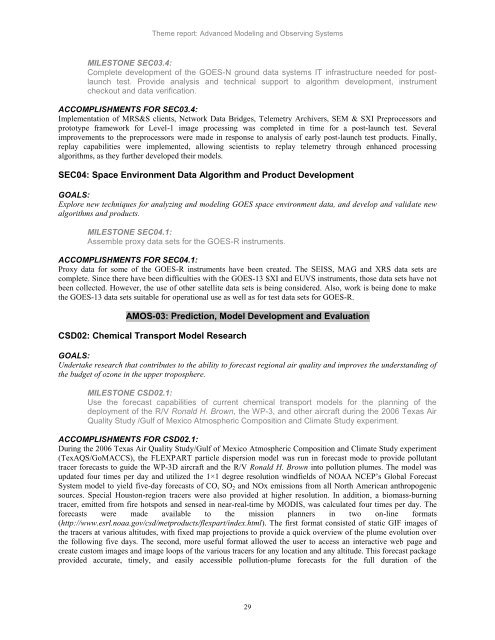Scientific Theme: Advanced Modeling and Observing Systems
Scientific Theme: Advanced Modeling and Observing Systems
Scientific Theme: Advanced Modeling and Observing Systems
Create successful ePaper yourself
Turn your PDF publications into a flip-book with our unique Google optimized e-Paper software.
<strong>Theme</strong> report: <strong>Advanced</strong> <strong>Modeling</strong> <strong>and</strong> <strong>Observing</strong> <strong>Systems</strong><br />
MILESTONE SEC03.4:<br />
Complete development of the GOES-N ground data systems IT infrastructure needed for postlaunch<br />
test. Provide analysis <strong>and</strong> technical support to algorithm development, instrument<br />
checkout <strong>and</strong> data verification.<br />
ACCOMPLISHMENTS FOR SEC03.4:<br />
Implementation of MRS&S clients, Network Data Bridges, Telemetry Archivers, SEM & SXI Preprocessors <strong>and</strong><br />
prototype framework for Level-1 image processing was completed in time for a post-launch test. Several<br />
improvements to the preprocessors were made in response to analysis of early post-launch test products. Finally,<br />
replay capabilities were implemented, allowing scientists to replay telemetry through enhanced processing<br />
algorithms, as they further developed their models.<br />
SEC04: Space Environment Data Algorithm <strong>and</strong> Product Development<br />
GOALS:<br />
Explore new techniques for analyzing <strong>and</strong> modeling GOES space environment data, <strong>and</strong> develop <strong>and</strong> validate new<br />
algorithms <strong>and</strong> products.<br />
MILESTONE SEC04.1:<br />
Assemble proxy data sets for the GOES-R instruments.<br />
ACCOMPLISHMENTS FOR SEC04.1:<br />
Proxy data for some of the GOES-R instruments have been created. The SEISS, MAG <strong>and</strong> XRS data sets are<br />
complete. Since there have been difficulties with the GOES-13 SXI <strong>and</strong> EUVS instruments, those data sets have not<br />
been collected. However, the use of other satellite data sets is being considered. Also, work is being done to make<br />
the GOES-13 data sets suitable for operational use as well as for test data sets for GOES-R.<br />
AMOS-03: Prediction, Model Development <strong>and</strong> Evaluation<br />
CSD02: Chemical Transport Model Research<br />
GOALS:<br />
Undertake research that contributes to the ability to forecast regional air quality <strong>and</strong> improves the underst<strong>and</strong>ing of<br />
the budget of ozone in the upper troposphere.<br />
MILESTONE CSD02.1:<br />
Use the forecast capabilities of current chemical transport models for the planning of the<br />
deployment of the R/V Ronald H. Brown, the WP-3, <strong>and</strong> other aircraft during the 2006 Texas Air<br />
Quality Study /Gulf of Mexico Atmospheric Composition <strong>and</strong> Climate Study experiment.<br />
ACCOMPLISHMENTS FOR CSD02.1:<br />
During the 2006 Texas Air Quality Study/Gulf of Mexico Atmospheric Composition <strong>and</strong> Climate Study experiment<br />
(TexAQS/GoMACCS), the FLEXPART particle dispersion model was run in forecast mode to provide pollutant<br />
tracer forecasts to guide the WP-3D aircraft <strong>and</strong> the R/V Ronald H. Brown into pollution plumes. The model was<br />
updated four times per day <strong>and</strong> utilized the 1×1 degree resolution windfields of NOAA NCEP‘s Global Forecast<br />
System model to yield five-day forecasts of CO, SO2 <strong>and</strong> NOx emissions from all North American anthropogenic<br />
sources. Special Houston-region tracers were also provided at higher resolution. In addition, a biomass-burning<br />
tracer, emitted from fire hotspots <strong>and</strong> sensed in near-real-time by MODIS, was calculated four times per day. The<br />
forecasts were made available to the mission planners in two on-line formats<br />
(http://www.esrl.noaa.gov/csd/metproducts/flexpart/index.html). The first format consisted of static GIF images of<br />
the tracers at various altitudes, with fixed map projections to provide a quick overview of the plume evolution over<br />
the following five days. The second, more useful format allowed the user to access an interactive web page <strong>and</strong><br />
create custom images <strong>and</strong> image loops of the various tracers for any location <strong>and</strong> any altitude. This forecast package<br />
provided accurate, timely, <strong>and</strong> easily accessible pollution-plume forecasts for the full duration of the<br />
29
















